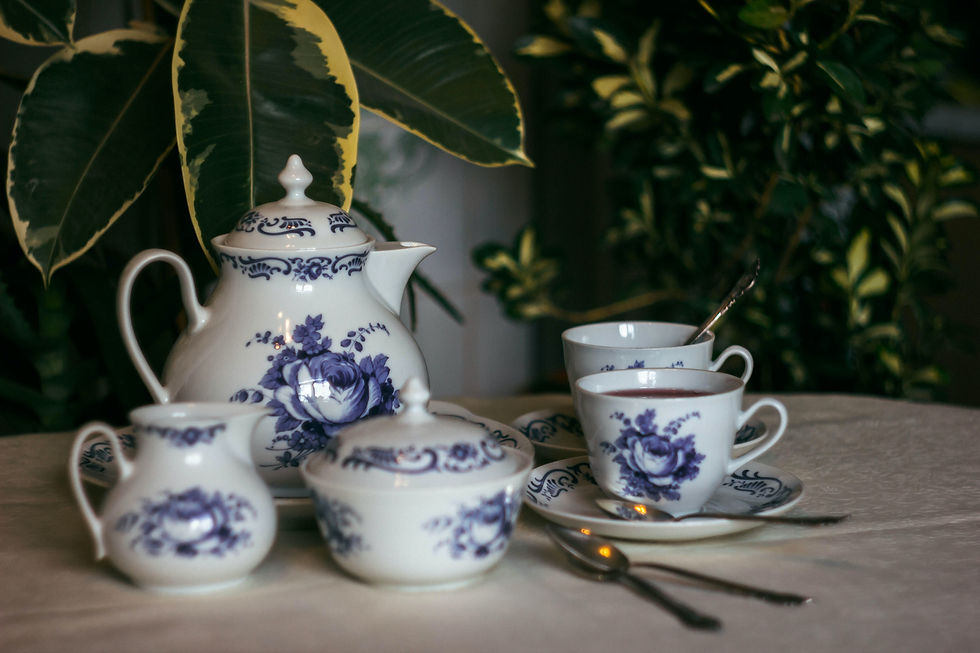Tea Ceremony Traditions Around the World: Inspiring Your Pottery Challenge
- Natasha Human

- May 6
- 3 min read

As our Clay Hands Showdown tea set challenge unfolds, let's steep ourselves in the rich traditions that have shaped tea vessels across cultures. Understanding these ceremonies might just spark fresh ideas for your teapot or sugar-and-milk set creations.
Japanese Chado: The Way of Tea
The Japanese tea ceremony (chado or sado) elevates tea preparation to a meditative art form. At its heart is the humble chawan—a tea bowl that embodies wabi-sabi principles of finding beauty in imperfection.
Traditional matcha bowls are often wide and deep, allowing the whisking of powdered green tea. Their earthy glazes and asymmetrical forms remind us that pottery isn't just about technical perfection; it's about creating vessels with presence and character.
Design inspiration: Consider how a seemingly simple form can hold cultural significance. What if your teapot embraced asymmetry or celebrated the natural characteristics of your clay body?
Chinese Gongfu Cha: The Art of Making Tea with Skill
Chinese tea ceremonies often feature a small clay teapot (typically Yixing purple clay), tiny cups, and various tools arranged on a dedicated tea tray. The ritual celebrates multiple short infusions from the same leaves, with each steep revealing different nuances of the tea.
The famous Yixing teapots are unglazed, allowing the clay to absorb tea oils over time—eventually seasoning the pot so it enhances the flavor of the tea. These pots are prized for their excellent heat retention and are often shaped to complement specific tea varieties.
Design inspiration: How might your teapot honor functionality while maintaining beautiful form? Could your handle placement or spout design improve the pouring experience?

Moroccan Tea: A Symbol of Hospitality
Moroccan tea ceremonies center around ornate metal teapots and colorful glass cups. The pouring is theatrical—the tea is lifted high above the cups, creating a thin stream that aerates the mint tea and produces a light foam.
While the vessels are different from what we'll create in clay, the emphasis on presentation offers valuable insights for our challenge. The decorative elements and dramatic pouring height remind us that serving tea can be performative.
Design inspiration: How might your teapot's spout facilitate beautiful pouring? Could your design incorporate decorative elements that tell a story?

British Afternoon Tea: Elegance in Everyday Life
The British tradition of afternoon tea features elegant bone china teapots, often accompanied by matching sugar bowls and milk jugs. These sets emphasize refinement through delicate forms, complementary pieces, and often floral decorations.
What makes a successful British tea set is the harmony between pieces—the way they relate to each other while maintaining their individual functions. The spout, handle, and lid of the teapot must be both practical and aesthetically pleasing.
Design inspiration: For those creating milk and sugar sets, how might you create visual conversation between separate pieces? What details could unite them as a cohesive collection?

South African Rooibos Tradition: Our Local Tea Heritage
Closer to home, our own rooibos tea traditionally was brewed in metal kettles over open fires, then served in simple enamel or ceramic mugs. The unpretentious vessels reflected the tea's connection to the land and its healing properties.
Today, rooibos is enjoyed in everything from delicate porcelain to rustic stoneware, showing how adaptable tea traditions can be.
Design inspiration: How might your local heritage influence your design? Could indigenous patterns or forms inform your work?

Bringing Tea Traditions to Your Clay Challenge
As you shape your clay for the Showdown, consider how these diverse traditions might inform your work:
What cultural aesthetics resonate with your personal style?
How can function and ceremony influence your design decisions?
What story do you want your teapot or sugar-and-milk set to tell?
Remember, your creation doesn't need to replicate traditional forms—it can be a contemporary interpretation inspired by these rich histories. The most compelling pieces often bridge tradition and innovation, just as tea ceremonies themselves evolve while honoring their roots.
We can't wait to see how these global inspirations might pour into your unique creations. The studio shelves are stocked with fresh clay, and our hearts are ready for your wonderful interpretations!





Comments